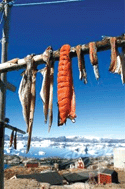 Researchers from Montreal, Canada, have investigated the link between iron deficiency and highly unsaturated fatty acids in the diet of Canadian Arctic Inuits. Impaired fatty acid synthesis has been noted in iron deficient animal models but data from humans is scarce. The typical diet of the Canadian Inuit consists primarily of red meat – an excellent source of heme iron and unsaturated n–3 fatty acids. However, recent reports have highlighted the prevalence of iron deficiency among the Inuit population – in fact these reports suggest that iron deficiency could affect up to 18% of Inuit children compared to 4.5% of American children. Although these statistics may seem counter-intuitive considering the iron and nutrient rich traditional red meat diet of the Inuit, recent trends in dietary behaviour amongst the population has seen a shift from the traditional nutrient rich diet to one containing more convenient “market foods”. This so-called “dietary transition” has resulted in concerns over inadequate iron intake – a concern which was virtually non-existent before. The high levels of iron deficiency in the Inuit population allowed investigation of the link between iron deficiency and fatty acid synthesis in humans.
Researchers from Montreal, Canada, have investigated the link between iron deficiency and highly unsaturated fatty acids in the diet of Canadian Arctic Inuits. Impaired fatty acid synthesis has been noted in iron deficient animal models but data from humans is scarce. The typical diet of the Canadian Inuit consists primarily of red meat – an excellent source of heme iron and unsaturated n–3 fatty acids. However, recent reports have highlighted the prevalence of iron deficiency among the Inuit population – in fact these reports suggest that iron deficiency could affect up to 18% of Inuit children compared to 4.5% of American children. Although these statistics may seem counter-intuitive considering the iron and nutrient rich traditional red meat diet of the Inuit, recent trends in dietary behaviour amongst the population has seen a shift from the traditional nutrient rich diet to one containing more convenient “market foods”. This so-called “dietary transition” has resulted in concerns over inadequate iron intake – a concern which was virtually non-existent before. The high levels of iron deficiency in the Inuit population allowed investigation of the link between iron deficiency and fatty acid synthesis in humans.
The traditional Inuit diet is also rich in compounds called n-3 highly unsaturated fatty acids (or n-3 HUFA), which have previously been shown to be protective against cardiovascular disease. From the results found in this study, a correlation was observed between the activity of desaturase 5 (a crucial enzyme in the biosynthesis of n-3 HUFA) and serum ferritin (an indicator of iron status) in the Inuit population. Therefore, in a shift away from the traditional red meat Inuit diet, n-3 HUFA consumption and biosynthesis are both reduced and exacerbated by the decreased iron levels. This potentially suggests that the Inuit population may be more susceptible to obesity and cardiovascular disease, in particular ischemic heart disease.
To read the full article for free, please follow the link below:
Is iron status associated with highly unsaturated fatty acid status among Canadian Arctic Inuit? Yuan E. Zhou, Stan Kubow and Grace M. Egeland, Food Funct., 2011, DOI: 10.1039/c1fo10051c










